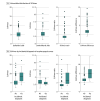Cancer in Patients With Incidental Asymmetric Oropharynx Positron Emission Tomography Uptake
- PMID: 39207815
- PMCID: PMC11362974
- DOI: 10.1001/jamaoto.2024.2556
Cancer in Patients With Incidental Asymmetric Oropharynx Positron Emission Tomography Uptake
Abstract
Importance: Asymmetric oropharynx uptake on positron emission tomography (PET)/computed tomography (CT) is a common incidental finding and often prompts otolaryngology referral to rule out malignancy; however, the true risk of malignancy based on this finding is unknown.
Objective: To identify the incidence of oropharynx cancer in patients with incidental asymmetric oropharynx PET uptake.
Design, setting, and participants: In this retrospective cohort study, patients 18 years and older undergoing PET/CT scans at Mayo Clinic between January 2001 and December 2018 were included. Patients with a history or pretest suspicion of oropharynx cancer were excluded. Data were analyzed from March 2021 to December 2023.
Exposure: Blinded radiologic review of imaging studies, including measurement of maximum standardized uptake values (SUVmax) of the ipsilateral side of concern and contralateral side. Retrospective medical record review for associated clinical data.
Main outcomes and measures: The primary study outcome was the incidence of oropharynx cancer diagnosis in patients with asymmetric oropharynx PET uptake. The primary outcome was formulated before data collection.
Results: Of the 1854 patients identified with asymmetric oropharynx PET uptake, 327 (17.6%) met inclusion criteria. Of these, 173 (52.9%) were male, and the median (range) age was 65.0 (24.8-90.7) years. The mean (SD) follow-up interval was 52.1 (43.4) months. A total of 18 of 327 patients (5.5%) were newly diagnosed with oropharynx cancer. The most common diagnosis was squamous cell carcinoma (n = 9), followed by lymphoma (n = 8), and sarcoma (n = 1). Patients with an incidental diagnosis of oropharynx cancer had higher mean (SD) ipsilateral SUVmax (8.7 [3.7] vs 5.3 [1.9]) and SUVmax ratio (3.0 [1.6] vs 1.6 [0.6]) compared with patients with normal examination findings. SUVmax ratio and difference were found to be good discriminators of oropharynx cancer, with areas under the receiver operating characteristic curve of 86.3% (95% CI, 76.4-94.6) and 85.8% (95% CI, 74.8-94.6), respectively. Patients with a new diagnosis of oropharynx cancer were more likely to have a corresponding CT abnormality than those with normal examination findings (6 of 18 [33%] vs 24 of 295 [8.1%]). Patients with concerning lesions on oropharynx palpation by an otolaryngology health care professional were significantly more likely to be diagnosed with oropharynx cancer compared with patients with normal examination findings (odds ratio, 28.4; 95% CI, 6.6-145.8).
Conclusions and relevance: In this cohort study, while incidental asymmetric oropharynx PET uptake was common, a new diagnosis of oropharynx cancer was not and potentially results in a large volume of unnecessary referrals and work-up. Using SUVmax ratio, SUVmax difference, and CT correlation may increase the benefit of referral. Patients with a palpable oropharynx lesion and asymmetric oropharynx PET uptake should undergo confirmatory biopsy.
Conflict of interest statement
Figures



Comment in
-
Beyond the AJR: Significance of Incidental Asymmetric Oropharynx FDG Uptake.AJR Am J Roentgenol. 2025 Jul;225(1):e2432356. doi: 10.2214/AJR.24.32356. Epub 2024 Nov 27. AJR Am J Roentgenol. 2025. PMID: 39602103 No abstract available.
Comment on
-
Asymmetric 18F-FDG Uptake in Oropharynx-PET Parameters to Minimize Unnecessary Interventions.JAMA Otolaryngol Head Neck Surg. 2024 Dec 1;150(12):1087-1088. doi: 10.1001/jamaoto.2024.2639. JAMA Otolaryngol Head Neck Surg. 2024. PMID: 39207819 No abstract available.
References
-
- Vansteenkiste JF, Stroobants SG, Dupont PJ, et al. ; Leuven Lung Cancer Group . Prognostic importance of the standardized uptake value on (18)F-fluoro-2-deoxy-glucose-positron emission tomography scan in non-small-cell lung cancer: an analysis of 125 cases. J Clin Oncol. 1999;17(10):3201-3206. doi: 10.1200/JCO.1999.17.10.3201 - DOI - PubMed
Publication types
MeSH terms
LinkOut - more resources
Full Text Sources
Miscellaneous

